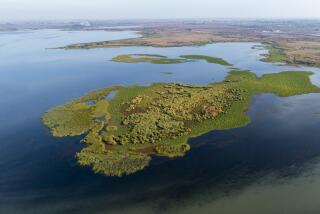County Joins Push to Establish Joint Effort to Reuse Waste Water
- Share via
County supervisors on Tuesday proposed the creation of a regional water reclamation project aimed at reducing the county’s dependence on outside water sources.
The plan, which includes selling treated waste water to other water-poor areas, envisions a reclamation network that would link the cities of Oceanside, Carlsbad, Escondido, Encinitas, Solana Beach and San Diego in future reclamation efforts.
The reclaimed water, though not clean enough for drinking, could be used for landscape and agricultural irrigation, industrial needs, reservoirs and “ground water recharge”--filling unused natural water basins.
“We do have a water crisis in this county,” Supervisor Susan Golding said. Golding claimed that, by 1991, the price of reclamation projects would become cost effective.
Ultimately, reclaimed water could be marketed to other arid regions to help defray the cost of imported water, Golding said.
90% of Water Imported
Currently, it is cheaper to import drinkable water than to reclaim undrinkable water from sewage. There are 18 water reclamation plants operating in San Diego County and seven more are proposed, under construction or not operating. Still, 90% of the water used here is imported, Golding said.
Golding and Supervisor Brian Bilbray questioned the proposed $1-billion upgrading of the City of San Diego’s sewage treatment plant on Point Loma. “What they should be considering is that they’ll still be dumping in the ocean,” Bilbray said. He said such a system is not cost effective.
A city manager’s report to the City Council Public Services and Safety Committee last week stated that reclamation was too expensive. Since reclaimed water is not as pure as drinking water, it requires a separate pipeline system to pump the water to potential users.
Rather than water reclamation, city studies and experiments in reusing waste water have focused on “total reuse” as drinking water, according to the report.
Imperial County Proposal
The county proposal is similar to an ambitious plan by Assemblyman Steve Peace that would send treated San Diego waste water to the Imperial Valley for irrigation purposes.
Peace, a Chula Vista Democrat who represents much of southern San Diego County and all of Imperial County, released a plan on March 6 that includes building a pipeline from San Diego over the mountains to Imperial County.
Like the Peace plan, the county proposal also would provide for treatment of Tijuana waste water before it would be sent into a series of treatment ponds.
For now, such reclamation projects are more expensive than importing water. The question is whether cities should experiment with reclamation or reuse technology, said Will Sniffin, deputy director of the city’s Water Utilities Department.
“We certainly think that water reclamation is . . . viable,” Sniffin said. “You get to a point where you have to start developing a project even if it’s more expensive” than buying water.
Sniffin said that, according to state officials, there is a potential to reclaim 17% of all waste water. Currently, only about 6.5% is being reclaimed.
Frank Maitski, the city’s project officer for aquaculture, said that the cost of reclaimed water, depending on the level of treatment, ranges from $400 to $1,000 an acre-foot. By comparison, buying potable water costs about $200 per acre-foot, Maitski said.
Tuesday’s action will require the county’s chief administrative officer to discuss setting up a reclamation system with the six cities. He will report back to the Board of Supervisors on April 28.
More to Read
Sign up for Essential California
The most important California stories and recommendations in your inbox every morning.
You may occasionally receive promotional content from the Los Angeles Times.









